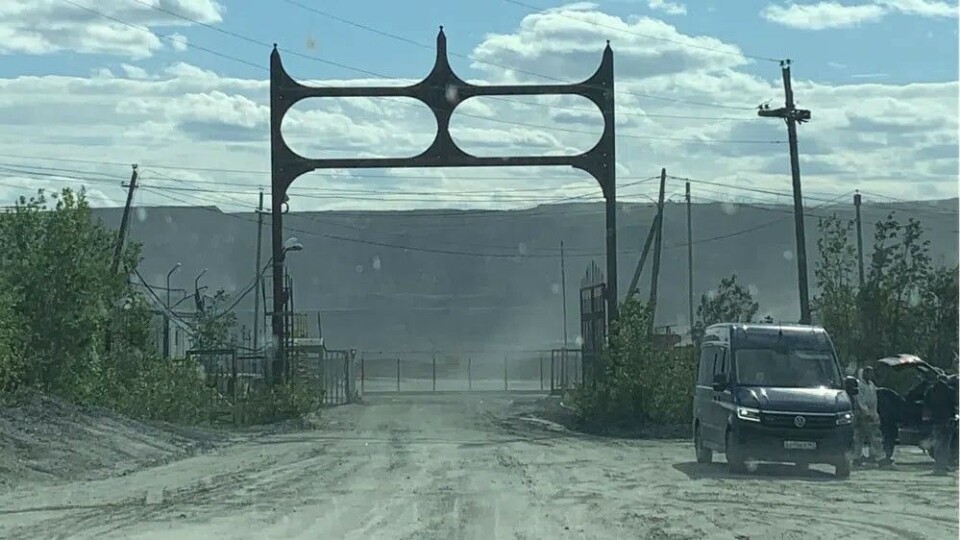
A pit and a yacht
Life is stagnation in Kovdor, a city that belongs to the oligarch Andrey Melnichenko, who also owns the most capacious yacht in the world
By Tatiana Britskaya
Kovdor stands on the edge of “the pit”. The pit is so large that it can be seen from space. There is nothing arrogant in the word “pit”. This is how the locals call the guarantor of their survival. It is the largest open pit in Russia and half the city works here. The quarry is over 600 meters deep. It produces apatite, iron ore and baddeleyite - zirconium oxide and there are only three such deposits in the world. When they use explosives in the pit, usually on Saturdays, the plates clink in everyone’s cupboards. An Ilyich, a communist era sign painted with silver paint near the mayor’s office points to way to the plant. Only a few years ago, said direction lay the path of every man in Kovdor. Now shift workers have begun to appear in the quarry and the locals are looking with greater hope to the road. 100 km from here is the federal highway leading to St. Petersburg and Finland is only 40 km away. But there is no road to either. Three years ago, traces of the mystical and ancient country of Hyperborea, a mythical people who lived in the far northern part of the known world, were “found” in Kovdor. Nevertheless, official recommendations are that the population ignore the west. It is better to float in the cosmos. Maybe hope will come from some extraterrestrial civilization.
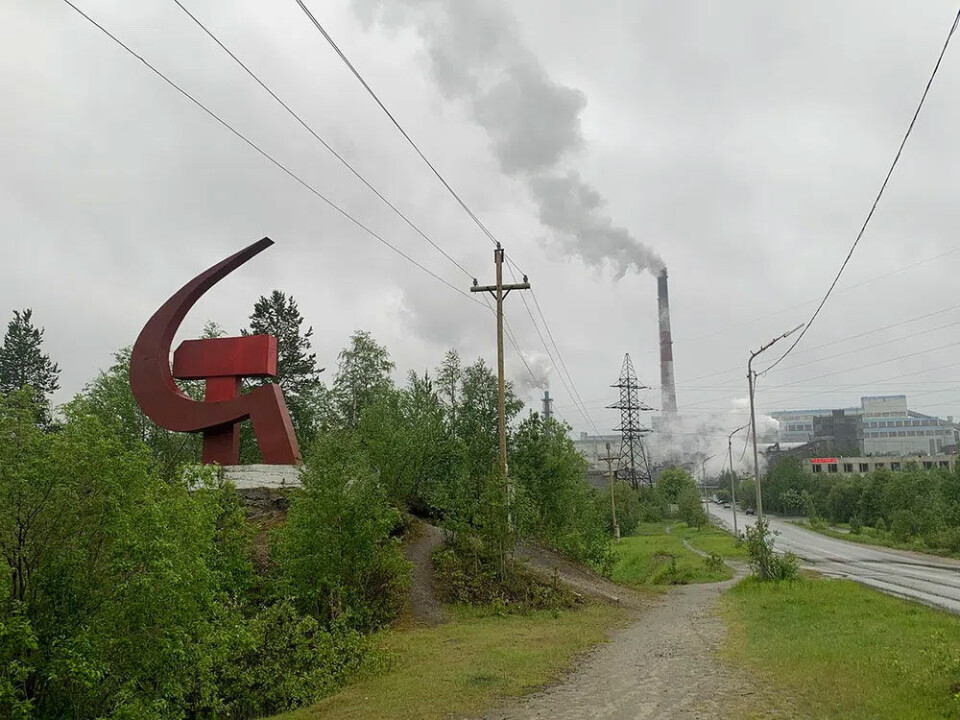
The trading rate of the “Lakhovka” against the ruble
Kovdor grew up on the edge of the quarry. Part of the deposit is located under the city. The first “miners” were convicts. The barracks, for obvious reasons, stood near the quarry hill. Then the quarry turned into a crater and the barracks into a city.
1200 prisoners of the Yonsk labor camp felled the forest, carried out the first mining operations and built a railway on the Pirenga. Officially, Kovdor’s birthday is considered June 1, 1953, the day construction on the plant began.
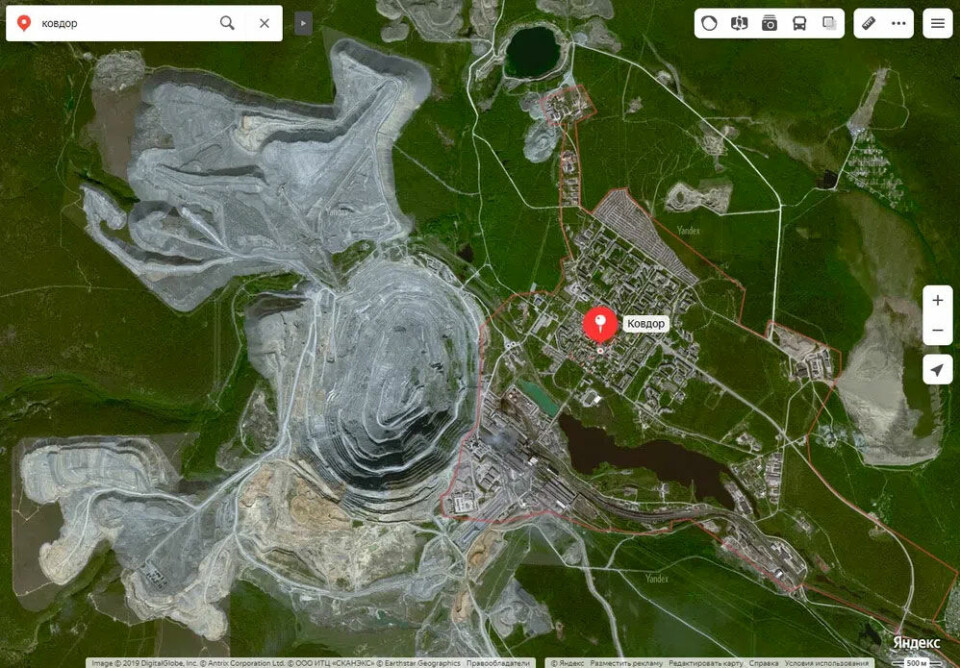
In the museum of local lore, there is a fragment of a log house on which a letter is scrawled concerning the final will and testament of a certain Krivoy, a native of the Sumy region of Ukraine, who was convicted in 1937. There were many such letters. These letters were only read however in the late 1980s when they began to dismantle the barracks to build a club built from its logs in the village of Yona. Unfortunately, the official story of Kovdor does not mention a single line about the perished convicts. Officially, it is believed that the plant was the brainchild of an All-Union Shock Komsomol construction site. “Shock construction” is a Soviet propaganda term for a high profile project.
20 years ago, Kovdorsky GOK was bought by EuroChem. Since then, the name of Andrey Melnichenko has been much more significant than the names of the successive mayors and governors for the 19 thousand local residents.
Andrey Melnichenko, according to Forbes, is the seventh ranked billionaire Russia and globally, he ranks 96th. He controls a fortune of $19.3 billion. Among his projects, he has opened a currency exchange office right in the main building of Moscow State University. He studied physics with other gifted students at the Kolmogorov boarding school. Melnichenko left the third year. MDM-Bank grew out of the exchange network and Melnichenko grew into a billionaire.
Forbes claims that the businessman is not a tax resident of Russia and lives on his yacht called the “A”. The “A” is the most spacious sailboat in the world.
The “A” was built at the shipyard in Kiel, Germany, the same place as the famous bark Sedov. The vessel is 142.8m from bow to stern, 25m at the beam and she is 12,700 tons deadweight. The “A” is estimated to be worth 400 million euro.
There is however no sea in Kovdor and neither is there a chance to see the owner of the “A”. An average price of a dvushka, a standard 2 two-room apartment, costs half a million here, about 5,600 euro. A three room “treshka” costs 900 thousand. Such rubles are reasonable. Kovdor is a typical monocity where everyone’s fate depends on the well-being of the main production. In the 90s, the combine owned a bread and dairy plant and almost everything else in the region. When there was no money at all, one of the red directors, Lakhov, issued his own currency. Salaries were paid by “lakhovka” and they were accepted in stores. The money to pay off the debts finally came from the new owners who promptly got rid of all non-core assets. All of the “assets” immediately died.
Now all products in Kovdor are imported. Murmansk’s strong shoulders are only 300 km away.
On the role of salary in a career
I took a drive to look at the quarry with Aleksey Markiv, a driver for BelAZ. BelAZ is a Belarusian automobile plant and one of the world’s largest manufacturers of large and especially large dump trucks. He is also the leader of their plant’s independent trade union. We drive down the dirt road to the lake with dark water. The shores of the lake sparkle as if sprinkled with gold and mica. This is the flooded “Kovdorslyuda” quarry, which used to compete for labor with the GOK mining and processing plant. Kovdorslyuda first became a production complex for the extraction of mica in 1936. In 2012, the concern went bankrupt. Evil tongues say that Kovdorslyuda played right into Eurochem’s hands by trying to offer workers competing salaries.
Now Kovdorsky GOK is the sole owner of the city. If you don’t like it, leave. There is no other job in the district and the results speak for themselves.
This summer, for example, Markiv was never given his 100 thousand rubles, about 1100 euro, in vacation pay. Accounting is now somewhere in Siberia, a move done to optimize the company structure. Now, there is nowhere local to go to figure things out. Markiv, who raised a scandal in the shop, was eventually paid but only over time and even then in installments. There are others who are already planning on demanding what is due after the holidays. “We are constantly told that we are 20 percent ahead of Mikhailovsky GOK in Zheleznogorsk in terms of wages. And I go there on vacation. At BelAZ, they have a 240-ton truck. The men receive the same “100 rubles” as we do in the north. But they get to drive right down the middle of the road and do not even have to deal with polar nights.”
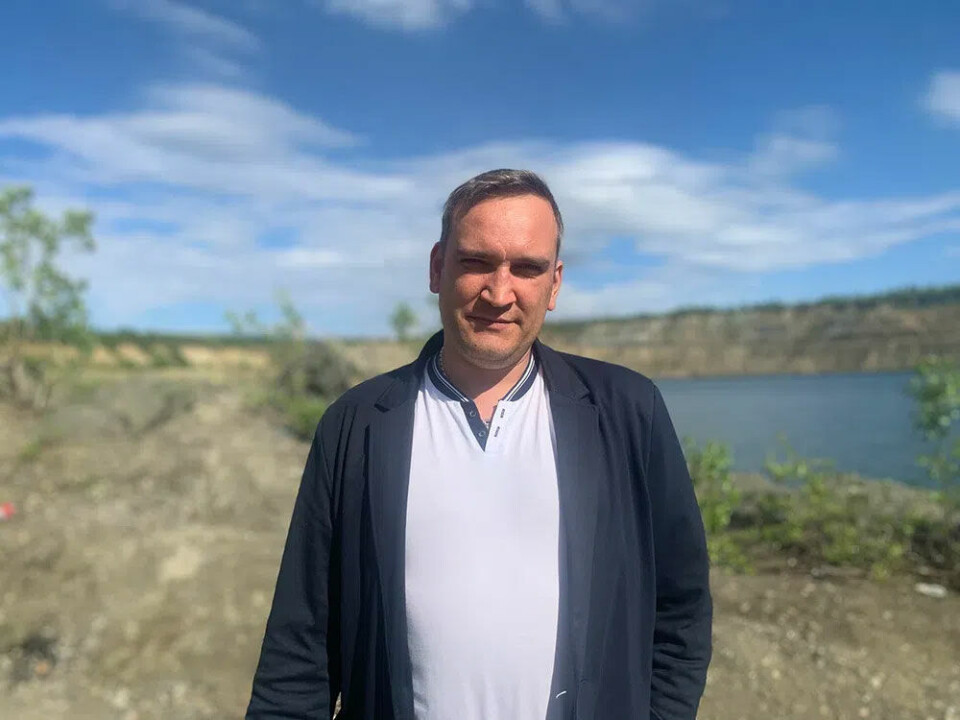
Under the water at our feet lies the hope of Kovdor. In this quarry are the mineral resources that would allow the city to get away from the status of a monotown and from dependence. They would have new jobs, competitive salaries and bring new taxes to the region. Phlogopite is used in the production of electrical insulation, porcelain and ceramics. There are only three deposits of such mica in the world and Kovdor is the only one in Russia. But since Kovdorslyuda’s closure, phlogopite has been being imported into the country from Madagascar.
A new resident of the Arctic zone, LLC “Phlogopite”, promises to revive the mica production. So far though, they have only managed to create 39 jobs. According to the SPARK system, the enterprise officially employs two people, has no equity capital and its general director and founder, Vitaly Manucharyan, runs a St. Petersburg company for sewing bags.
Three dozen types of ore are found in Kovdor’s land. EuroChem’s PR specialists insist that the reserves in the Zhelezny mine will last for another 100 years. But six months ago, Murmansk Governor Andrei Chibis announced that the reserves in the quarry would run out in 2028. Chibis’s statement caused confusion in the city. It was unclear what the governor’s statement was based on and it remains unclear to this day. They are currently using explosives on the walls of the pit in order to expand them. The richest ore is under the dumps on the western side. And recently, shift workers have begun to appear in Kovdor. The combine has long threatened to replace “greyhound” local workers with newcomers.
“The first scabs did some work, realized that they had been deceived and disappeared into the night,” laughs heavy-duty truck driver, Stepan Hylka, “But now other shipments are being brought in by several new people. There are five people in my shift. Nobody knows how much they are getting paid. And then they complain that they are being paid less than promised and that they must work seven days a week. One new guy had to work somewhere in the mine and his the salary was under 90 thousand plus something extra for “working in harmful conditions”. We don’t get harmful condition pay but the salary is the same. He packed up and went home. “
The “harmful working conditions” rating was removed in 2016 after a special assessment. The working conditions in the quarry were assessed as acceptable, class 2, which is comparable to the work of a computer operator.
“We live in shit”
Alexei first captured media attention nine years ago during the last major strike at the combine. The BelAZ union delivered an ultimatum to the leadership to either raise salaries or the men were heading elsewhere to be “kuzovers”, builders of light auto frames. The directors did not even go to negotiations with the “boozoters”, the shit disturbers. The men went on strike.
At our first meeting, Markiv was 31 years old. We drank coffee in a “stacklyashka”, a glass, concrete and steel building on Lenin Square with the exotic name of “The Coliseum”. During our conversation, the dishes were rattled several times by explosions. Alexey took over leadership of the trade union after Vadim Proyaev was fired for the strike. Markiv explained that people did not get any raises. Everything was simply tolerated by the GOK. Their only concession was to account for inflation. The strikers had only asked for 20%.
The people stood up for themselves. They felt the owners saw them as no better than cattle. Salaries have since been raised.
Three years later, we met again in Kovdor. This time at a funeral home. This was Vadim Proyaev new “office”. Proyaev was then another former head of the trade union of the transport department of the GOK. He never managed to recover at the plant and got a job planning coffins. Philosophically, he explained that now, he knew everything about everyone. You can try to pass by his quiet office but you will not get away with it.
Markiv was also fired. During his time, he became the first little man in the history of the plant to defeat the leviathans. He beat them in court and returned to work a winner. Soon after his victory, the all-powerful directors of the GOK quietly resigned.
For this third meeting, we return once more to the Coliseum. Alexei will be 40 in a couple of days. He has returned to driving BelAZs and is raising two sons. He himself went into politics for a while, fighting for office against a United Russia heavyweight and went back to school to receive “higher” education. And we are not alone in this visit. Shady vehicles have been following me around and offering to take me where I need to go since I got here.
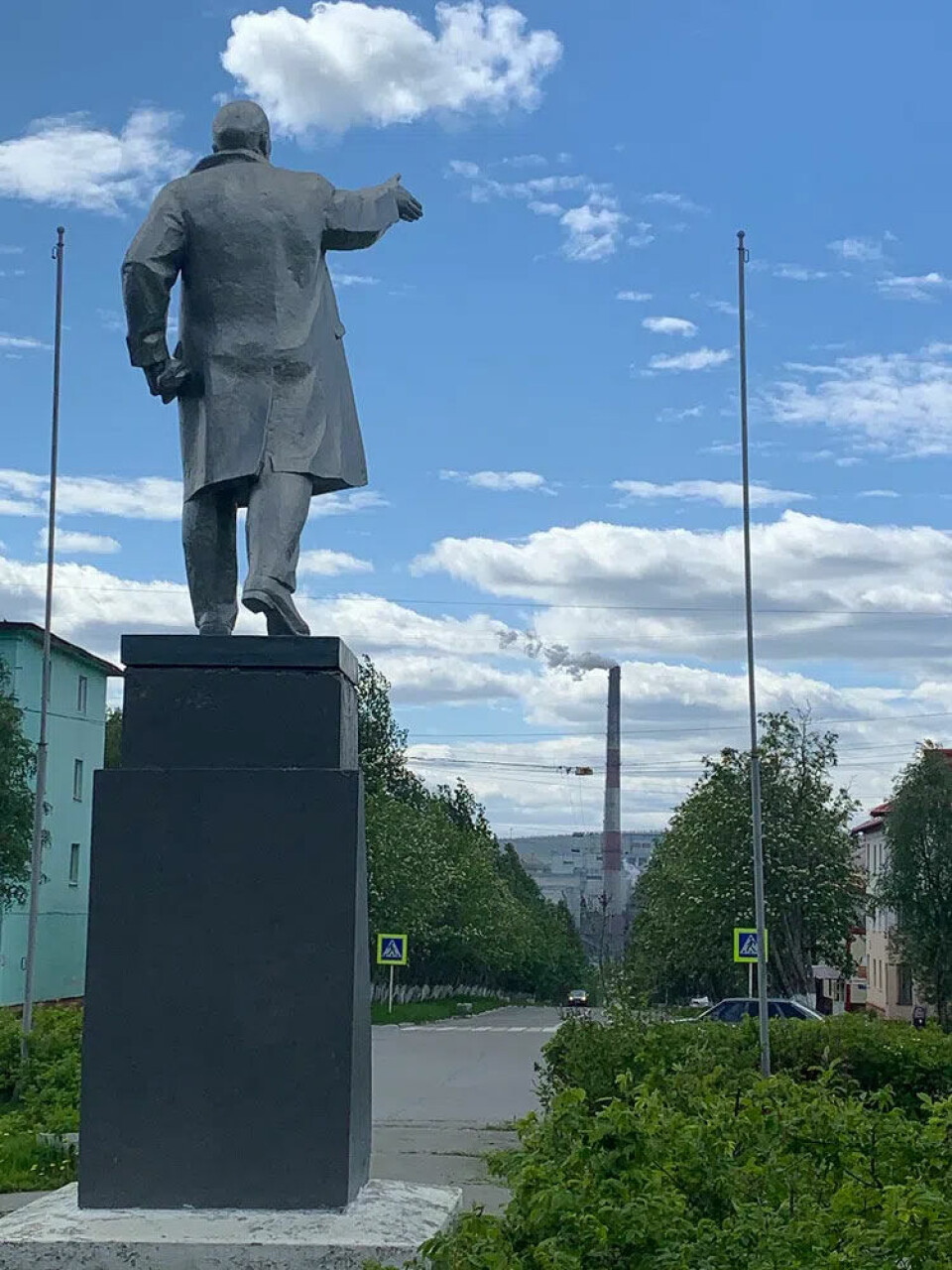
True, undercover surveillance makes things difficult in a small town. Everyone knows each other and two gray “Ladas” following someone quickly creates cold eyes. This feeling also came from a sporty-looking man in dark glasses who spent hours sunbathing on the bench opposite my hotel. The night before, he enthusiastically filmed the sights of the abandoned village of Rikolatva on his phone. I had stopped there hours earlier along the way.
“Why are you surprised? You have arrived! Of course, they are interested in everything you do,” says the director of the hotel calmly. At nine in the morning, he came in to say that the local FSB officers wanted to talk to me immediately. I told them I did not want to talk and the visitors left.
So instead of a conversation, we got an escort and our comrades in the grey Ladas followed me all over Kovdor. During this, we stopped to contemplate the ruined bathhouse that burned down more than a year ago. The remains are a five-story building with broken glass. It is an unfinished high-rise that meets everyone at the entrance to the city. The ruins of the “Kovdorslyuda” office are in this building. Behind the gray city hall building, everything has been dug up. The townspeople have been promised a garden city. They had first promised this even before the last elections. Somehow though, it hasn’t worked out in five years. Maybe the local FSB wanted someone to open their eyes to these ruins and to show voters the true quality of life before the elections. Hopefully, this was the case and the excursion was helpful.
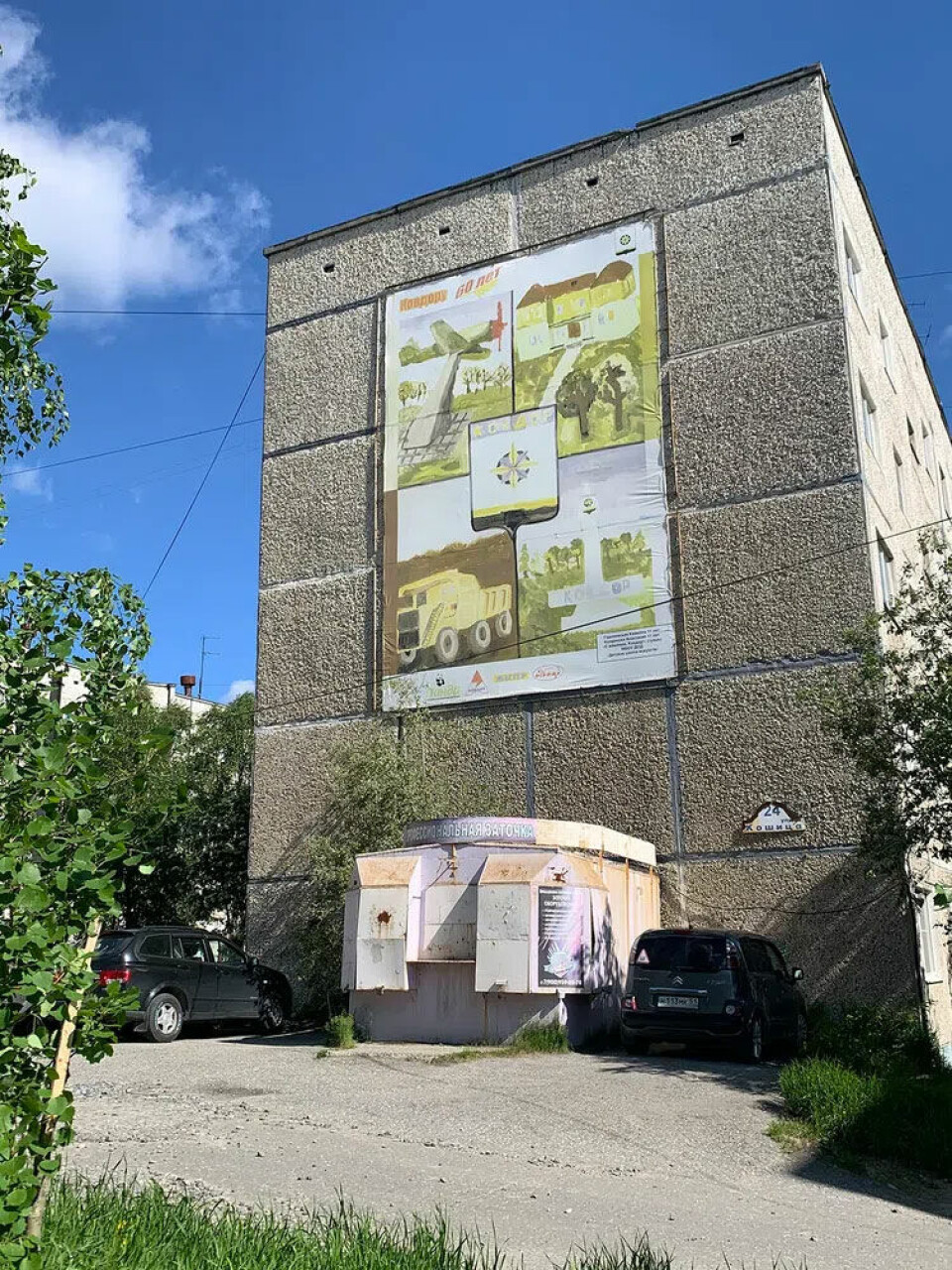
During the last elections, the townspeople were shown an 800 million ruble (€9 million) reconstruction project for the main square. They promised to fill in the ravine and lay out a sidewalk with paving bricks. Five years later, only a bust of Nicholas II has appeared there. That and a church made of silicate bricks. The plaque on the tsar’s pedestal indicates that the shooting of the royal family was a “ritual murder.” The bust was erected at the initiative of a local boxer. The press release wrote that the idea of erecting a monument to the tsar, who was shot 35 years before the city was founded, was to “perpetuate the tsar’s contribution to the development of the Kola Arctic.” The church and the bust stand opposite the “Hyperborea” restaurant on the edge of the ravine.
And the true story is that the autocrat never actually made it to any of these places.
Alexei’s list of complaints show his frustration. They also promised to make Pobeda Street for pedestrians only and to install decorative paving. The asphalt is still crooked and there is hardly any greenery. “What they did was to come and lay a few bricks, shoot a photo and then went to report upstairs. After this, they have done nothing for five years. But watch what happens. Now, with the elections coming up, they will do something so that they might get some votes. This is ridiculous and insulting.” Recently, in a report to the regional Duma, Governor Chibis said that according to the results of the urban environment quality of life index, Kovdor was included in the list of cities that are comfortable to live in. But the maternity hospital has been closed for 10 years. The hospital does function but has its complaints. It seems there is only one toilet available in surgery and the men have to share with the women. To this complaint, management answered only that separate toilets were not provided by the project.
Across from the supermarket, there are plywood triangles with balloons tied to them advertising “Vologda jam”. On a boarded-up stall, there are tattered advertisements for a “circus”.
“This is what kills me,” Markiv says dejectedly, “They raised the Tower Bridge in London for Melnichenko and still, we live in shit.
To Hyperborea at BelAZ
There are two hotels in the city plus a dispensary. You cannot book a ticket online, you have to call. In a room belonging to the GOK hotel, they consider a towel cut in half to be an economically reasonable design for two guests. There is the ancient smell of Soviet service and keys with wooden cones with the numbers attached to them. The hotel restaurant offers venison and bear meat as well as vodka infused with lichen and cloudberries. These are however reserved for “special services”.
“Hyperborea” opened in Kovdor in 2018. A serious decision was made that the legendary civilization was indeed located here. This agreement came from the council of the district deputies. It was EuroChem that initiated the bureaucratic procedures. I would venture to suggest that this plan was to serve people the legend instead of feeding the dissatisfied.
In the end, the GOK has already purchased a star from the sky to give to the people of Kovdor as a gift. Literally, since 2003, one of the stars in the constellation of Cancer has been called Kovdor. Now, though mythical, they are giving the town a whole country.
They came up with this idea at a meeting between EuroChem’s management and city officials. Since then, the GOK has spared no expense for the PR for this fabulous concept. It seems there is no sin in spreading urban legends. And all their supporters point to Veliky Ustyug, a town that legally and officially became the homeland of Santa Claus as an example. The Hyperborean veil has not however affected life in Kovdor and this was despite how hard the local authorities try to introduce it into the townspeople’s lives. Athletes are being invited here for the “Hyperborean Games”, runners for the “Hyperborean Mile”, music lovers can sing the “Hyperborean Flute”, mystics are invited to an enlightenment sessions with a “Hyperborean Shaman”, art connoisseurs are shown the “Hyperborean Palette” and even preschoolers are called to the platform. Even the most severe possibilities for the new Hyperborean brand were not forgotten as the words “Kovdor - the capital of Hyperborea” can be written on the driver’s door making it possible to brand their life’s work at “Hyperborean BelAZ”. And a year ago, they began issuing “Hyperborean passports”, signed by the legendary head of the mythical region, “Mr. Kuvvtom”. Mr. Sharikov also noted that “a person without documents is strictly prohibited.” even if they are Hyperborean.
Visitors are promised a complete immersion into the mysticism and magic. True, you first need to get there. One has to travel 3 to 7 kilometers through the forests to get to each of the Hyperborean artifact exhibitions. And of course, there is no transport.
The most persistent of the “artifacts” are somewhat dubious though. The Gokovo TV channel, competing with REN-TV in the mystical frenzy, now and then demonstrates a pile of stones or a complex relief of a rock taken from a quadrocopter to the public. The reports assure viewers with persistence that these are part of an ancient temple or the profile of a Hyperborean building. In one of the videos for example, the journalist claims that the names of hills near the city are translated from the Sami (!) language as “Apollo” and “Artemis”, which proves their Hyperborean essence. In another, without the slightest trace of disbelief, he insists that 20 thousand years ago, there was a legendary civilization, Hyperborea, that was protected by a wall from enemies and evil spirits.
It is not possible to find out in detail what the author of these scenarios had in mind when he wrote them. He has unfortunately been taken into custody for seducing a minor.
Sasha, the director of the hotel is smiling, blushing and alone. “We are now registering as a tour operator because Murmansk and Kirov companies are ready to share tourists with us. Frankly speaking, if a tourist goes to visit Murmansk for ten days, they have nothing to do there by the third day.” He came here seven years ago from Samara on a good contract and, it seems, remains cheerful only thanks to regular overseas vacations. He believes in the development of local tourism but admits that until they actually build decent roads to the potential attractions, it is difficult to show them to guests.
Alexander tactfully avoids the question of the authenticity of the artifacts. The local labyrinth is not at all like the ones in the north. They are neat, not overgrown with grass and a bit resemble a Tibetan mandala. “So they put this online recently and my friends went to have a look,” laughs Julia, a local teacher in response to my bewilderment. “Everyone in the city knows all about it.”
“We need recreation centers for tourists who are willing to head out for the long hike. We need amenities and food,” Sasha continues about the sore subject, “I invited one camp site owner into a deal but he replied that he wouldn’t do anything except take 500 rubles from each hiker for the right to pass through his territory.”
Sasha also understands that it is necessary to show the tourists the quarry in Kovdor. No matter what fairy tale you come up with, people are interested in the present. This is not the case in all of Russia but as soon as an observation deck gets built at the GOK, the sober Alexander will lead the guests there.
Diagnosis of Karma
I met with Olga Zhuravleva in a sausage shop at the bus stop. Olga is a medium. More precisely, she is a rodologist and a regressologist. Rodology is a pseudoscientific concept that says that the events of human life depend on the biography of our ancestors, everyone belonging to the Dokuchaevs. Those adept at the art insist on the scientific character of their knowledge.
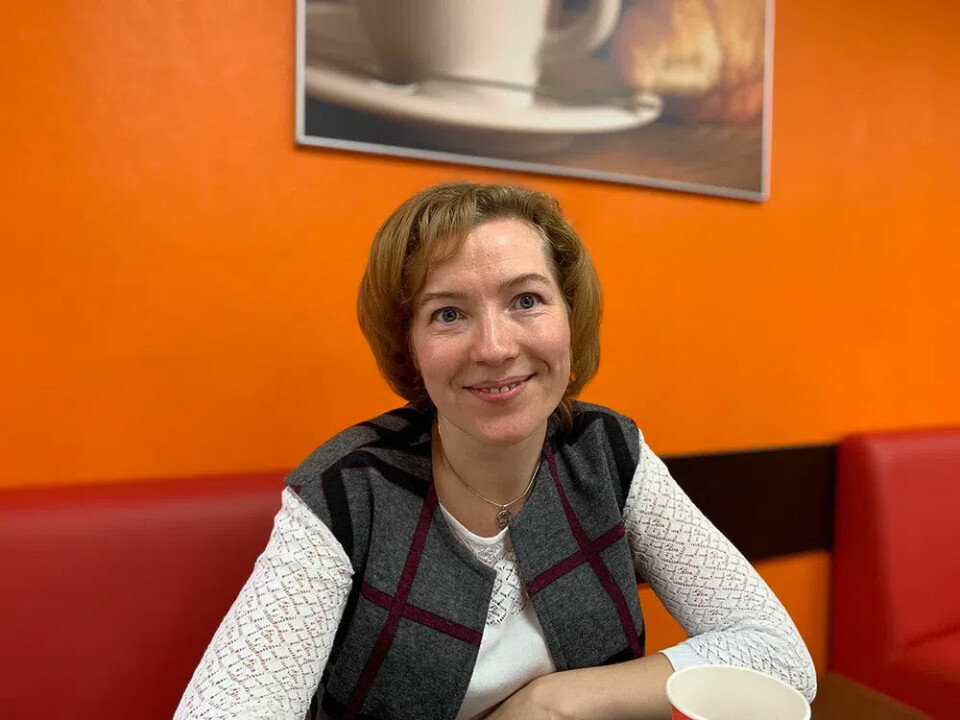
To study at the “Academy of Rodology”, Olga used money that her family had saved up for the first installment of their mortgage. Now she has certificates as a “Rodologist for personal histories”, “Shamanic practices”, “Advanced techniques of interaction with the subtleties of the world” and as a “Professional ancestor caller”. Two hours of consultation cost 5,000 rubles. Between contacts with the subtle world, Olga works at the GOK but is currently on maternity leave. She invites tourists “to meet their ancestral roots in nature through the four elements.”
“It is easier to work with people who come to a place of power because in almost every case, they expect to see more than just the “Warrior’s Head” or to look at the “Ruby Canyon”. They begin to feel and perceive the world at the level of energy.” She begins escorting people through the mystical world from the moment they get into the car and drive off together.
“I’m already slowly beginning certain conversations with you. I’m already beginning to tear you away from this reality of ours and turn the moment into something that is just a little bit different.” This is how Zhuravleva mysteriously talks about the methods of her work.
The program includes a worship of the spirits of the wind, trees and the memories of our ancestors as well as a full range of mystical practices, all served under a pseudoscientific sauce. The logic goes something like this. If your ancestors were dispossessed, you will always be afraid to get rich simply from remembering karmically that surplus grain will be taken away anyway. But, having worked with a specially trained master, this karma can be corrected and understood, as in the “Heart of a Dog”. Life’s real purpose is still ahead of you.”
Olga laments that she does not know Alevtina Sergina from the village of Yona, who is called a “noyd” there, a female shaman. Other Sami consider her services just a regular product of tourism and are highly critical of the liberties in dress she takes and the exploitation of Sami religious practices.
Aleksey Tolmachev, the director of Tallatour, has a calmer attitude towards shamanism and places of power. He believes in his “artifact”, a stone found on a fishing trip allegedly with the profile of a Hyperborean. Alexey never shows the stone to anyone for fear of damaging the valuable find. In the meantime, he takes tourists to other hard-to-reach places of the region. And, of course, he also works at the GOK. Everyone here works at the GOK, both mystics and skeptics.
“Now there are few tourists,” says Tolmachev, “Kovdor is not well promoted despite having much to attract guests. The ski complex, for example, is excellent and the prices are much lower than in neighboring Kirovsk.”
Tolmachev believes in Hyperborea. He believes that the drawing on his stone was made using ancient technologies unknown to our time. He believes this comparable to the pyramids. He says that he showed his stone to a geologist and she said that the drawing was hand-made. But he does not believe in the “rune stone” theory, which is the only way to see the tourist program available right in Kovdor. He doesn’t feel any particular energy next to the cube-shaped cobblestone lying in the bushes near the entrance to the plant. Others say they can. For example, the writer Kulagina, who calls herself “Miss Arctic”, came and immediately said that she felt it. She made contact!
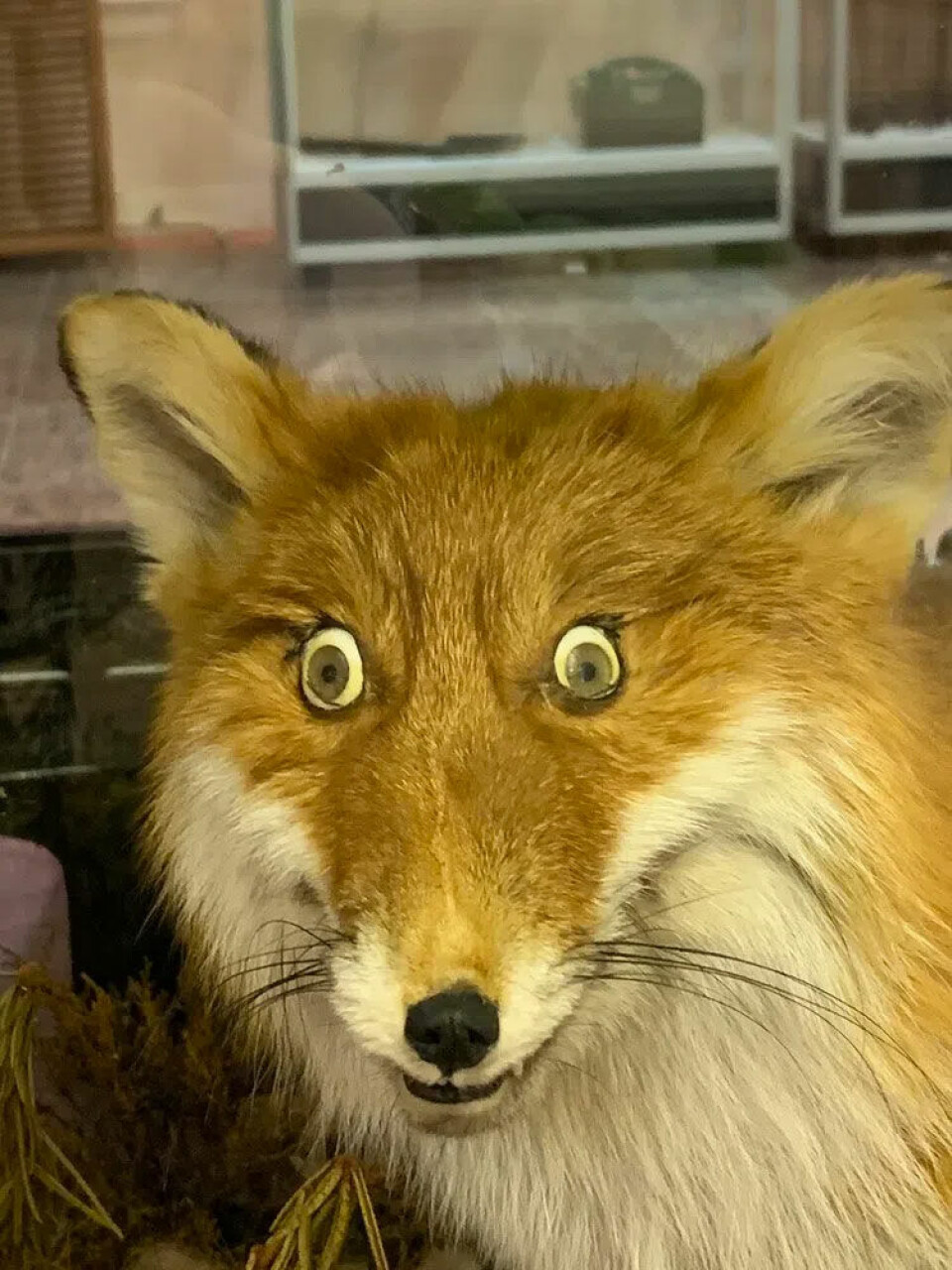
Personally, I felt a sense of contact with some extraterrestrial civilization in the “animals” section of the local history museum when I saw with my own eyes the famous “stoned fox” himself sitting behind a glass showcase. The museum is proud of him. They say that half of the country knows about the exhibit and everyone wants to be photographed with him!
In the evening, local graduates make their appearances in the “Hyperborea” cafe as well as in a restaurant with a no less sonorous name, the “Aristocrat”. In the “Coliseum”, an older audience dances to the fiery rhythms of three years ago. Mirrors, neon lights and teapots with strainers dangling from spouts…
Just after the “Coliseum” is the second GOK checkpoint. There is a metal arch and the quarry is behind it hidden in the mists like the entrance to Tolkien’s Mordor. A nice lady in a security uniform flatly refuses to show me the way to the monument to the 100-millionth ton of ore. “Why do you need it?” Soon the police show up, having delicately followed my car. Needless to say, tourists are protected here.
On the balcony, Alexey Markiv smokes for a long time and looks at his hometown. For the first time, he admits to thinking about leaving. “If I succeed here, they will come, pat me on the shoulder and say “Well done! We proudly shake your hand.” And if it doesn’t work out, they will just call me a moron and ask where I thought I was climbing.” Sadly, this is the way he characterizes the mood of the public. Markiv hopes for a project to build a road to the Russian-Finnish border. If money is found for that, Alexey believes that the city will come to life and he won’t have to worry about leaving any more.















